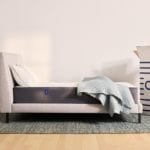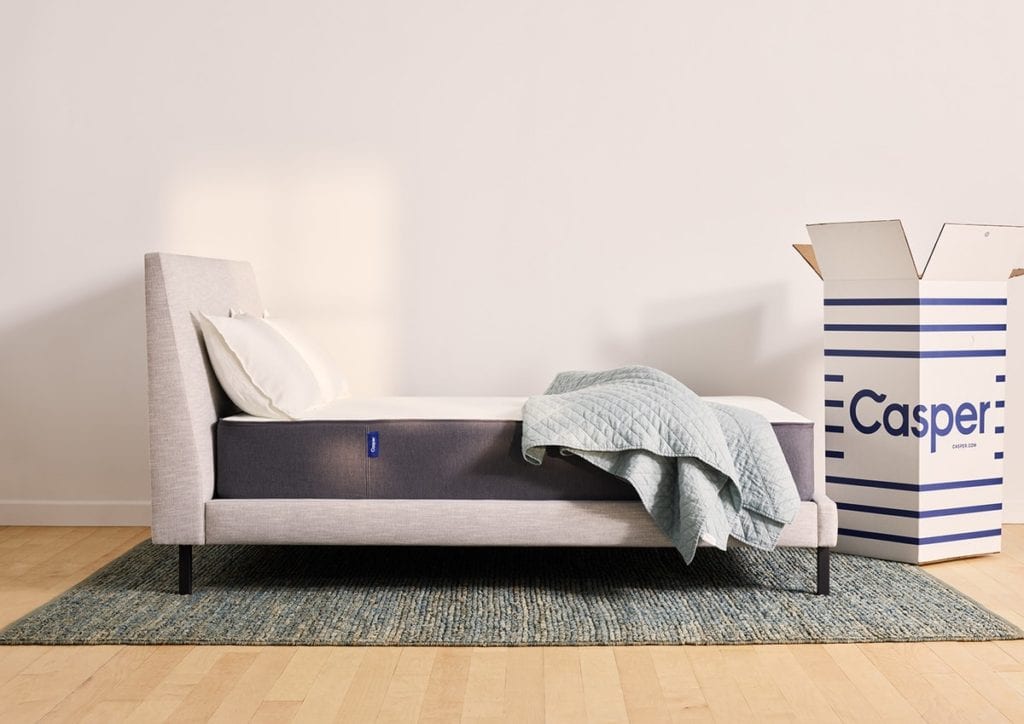
The Casper Mattress
One of the “The Disrupters”
When The Casper Mattress and Yogabed were put on the market in 2014, “The Disrupters” soon became a nickname for these upstarts. “The industry is growing at 3 or 4 percent (a year), and almost all of that growth is going to the disrupters,” said Saatva co-founder Ricky Joshi.
They joined Tuft & Needle (T&N) and BedInABox (BIAB) as online-only mattresses, bypassing traditional retailers and shipping to the customer’s front door. Together they challenged the establishment.
One Model Geared To The Average Customer
Unlike, BedInABox (BIAB), Casper Sleep, Yogabed, and T&N each offered only one model, geared to the average customer, to simplify shopping and lower costs. These all-foam mattresses were sold at lower price points than Tempur-Pedic models. This marked the blossoming of the boxed beds movement, which has changed the way mattresses are sold. Many traditional manufacturers joined in, with mattresses such as the Cocoon by Sealy, Ghostbed (Nature’s Sleep), and #BestMattressEver by Brooklyn Bedding.
One Size Does NOT Fit All
Initially, having only one model gave an advantage to the startups. It simplified marketing and shopping. Some adjustments were made by these new brands to their mattresses in response to customer feedback. But still, selling to the middle left unsatisfied customers on either side. Newer and older established bedding manufacturers had begun following the lead of the startups with their own mattress-in-a-box offerings. These offerings had their own brand websites so shoppers could focus on the boxed beds without wading through all the other models.
Even in following the lead of the startups, the standard companies began leading with choices of firmness and a few other features in their boxable beds. For instance, the Snuggle-Pedic mattress could be customized. Just as with gloves, shoes, and clothes, they knew that one size does NOT fit all.
Now even the original disrupters have more than one mattress model. This is to broaden the appeal of the brand. It also extends the disruption beyond the middle of the market. It is a classic case of recognizing and meeting demand.
Construction of The Casper Mattress
The original Casper Mattress has matured and now has siblings, The Wave and The Essential. The construction of the original model underwent upgrading but still retained latex over memory foam in the top layers until the latest revision in 2017.
In mid-2015, when The Casper Mattress was reviewed on Beds.org, it had three layers: 1½” of latex, 1½” of memory foam, and a 7” base support layer. By a year later, this had become a four-layer mattress. The base was reduced to 5½”, and a 1½” transition layer inserted between it and the memory foam. Between then and March 2017, the latex in the top layer was replaced with a latex-like foam.
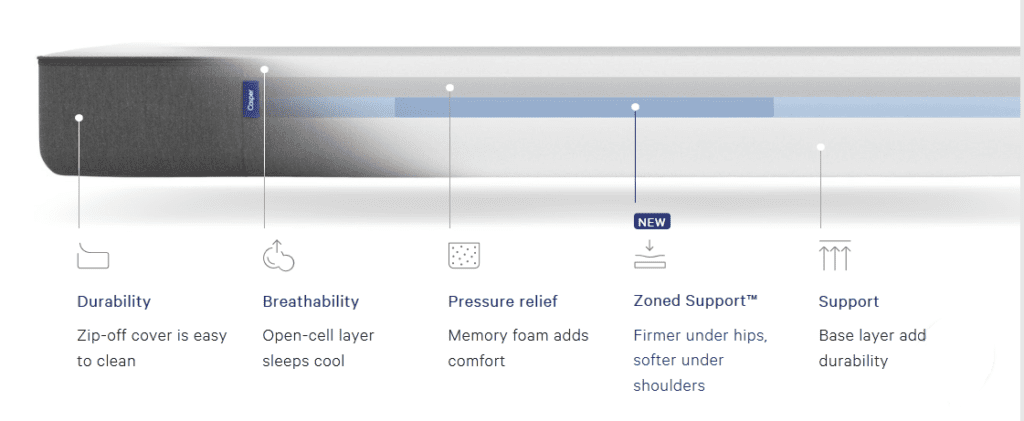
Cover
The cover of the Casper is a polyester blend. Nothing further is said about its composition. One older review says that it is woven, but another (newer) description calls it stretchy. If this is woven, not knit, then the blend might include some spandex.
Top Comfort Layer
The 2017 revision of The Casper Mattress goes beyond earlier ones, changing the composition of the top layer. No longer memory foam, it is now a latex-like foam, which is polyurethane foam engineered to have the properties of latex. Whatever was done to the polyurethane foam, some say it works better in this mattress than the latex did. It’s only fair to note that the latex in the earlier versions was Dunlop process, not Talalay. Although Dunlop process foam is latex (whether natural or synthetic), it does not have the evenly distributed density of Talalay latex. In this case, latex-like polyurethane foam would be more like Talalay latex, so it is not hard to see it working better with memory foam.
This top layer is described as breathable. It is open-cell foam, but the descriptions also mention pores. Most Talalay latex (but not all), is vertically ventilated with small pores all the way through the layer. However, the “pores” named in Casper’s description appear to mean where cells open to the surface of the foam since it is the open-cell structure which is credited for the cooling.
Second Comfort Layer
As in the previous versions of the Casper mattress, the second layer is memory foam. Casper Sleep calls this a pressure-relief layer, highlighting the signature benefit of memory foam’s pressure-relieving conformity – its memory.
The density of this memory foam is 4 lbs/ft³, the same as the top layer of Tri-Pedic and TEMPUR-Cloud mattresses. The 5-lb memory foam these have in the second layer provides more conformity.
Zoned Transition Layer
The transition layer is zoned for firmer support under the mid-section of the sleeper. Since this is the heaviest portion of the body, firmer support here is intended to keep the spine in line instead of sagging with a hammocking effect. Casper does this by using firmer foam in the middle of this layer and less firm foam at the ends. Though the ratio of the zones is disclosed neither on their site nor on Amazon, it may be 33%-34%-33%.
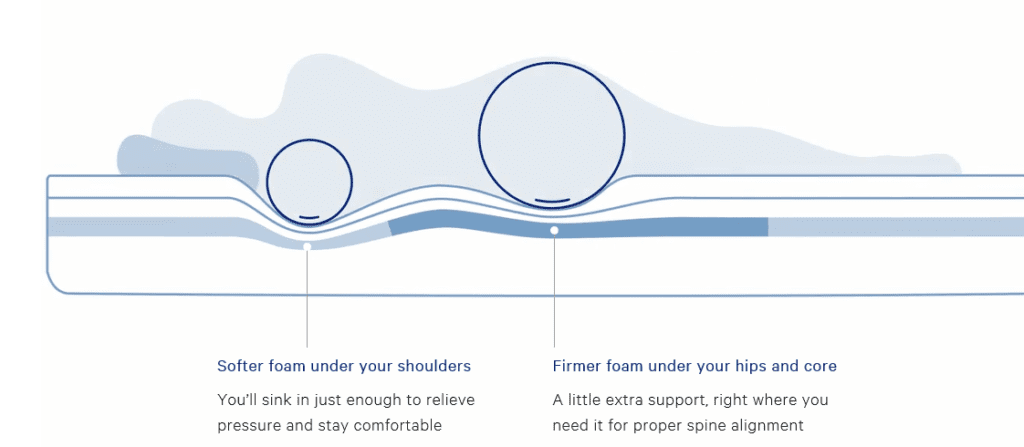
Support Base Layer
This provides the primary support for the mattress. The support base layer – also called the “Foundation Layer” – is very firm. The role of this layer has been to keep the softer comfort foams under the sleepers from bottoming out.
Cooling The Casper Mattress
Early on, memory foam mattresses earned a reputation for sleeping hot. As the saying goes, this “came with the territory.” The pressure-relieving conformity for which memory foam is valued comes from its heat sensitivity. As the foam gets warmer, it gets softer, and the body sinks in. The larger the part of the body, the more heat, and the more that part sinks in. The ideal density for this conformity is 5 lbs/ft³. Since memory foam naturally gets hot, manufacturers looked for ways to beat the heat.
The first way was open-cell memory foam. The original Tempur Material was closed-cell foam. The heat was trapped in the foam. Open-cell foam allows air to filter through. Open-cell structure is now the standard for memory foam. Even then, it can still become too warm for some users.
Another way to cool memory foam is by adding gel to the foam during processing. However, though this is a good start, it has its limitations. Gel may be conductive, absorbing the heat, then passing it on to gel further inside, but it will reach its limit (heat saturation), where it cannot absorb any more heat. Then the foam warms up.
Another way to control the temperature of memory foam is to use a lesser density foam in the top layer. This tactic, pioneered in the Tri-Pedic by Selectabed, then used by Tempur-Pedic, puts 4-lb. memory foam in the top comfort layer, then has a 5-lb. second layer. Being cooler is a side effect. The original purpose was a quicker response with the lighter foam, which was more pressure sensitive at room temperature than the 5-lb. foam. Because it was also less heat sensitive, it did not become as warm.
Akin to this concept is Casper’s use of latex (now latex-like foam) on top of the memory foam. Besides absorbing less heat than memory foam, latex and latex-like foam for mattresses is perforated (vertically ventilated), letting more air flow through than open-cell foam alone.
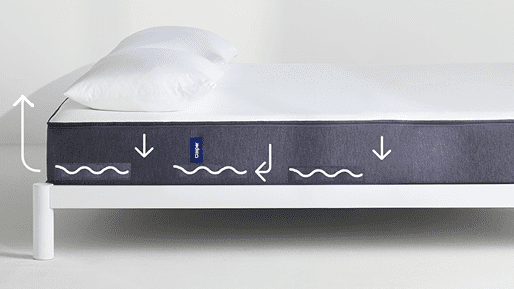
In The Casper Mattress, both the latex-like foam and the memory foam are open-cell foams. Their description says, “We use open-cell foams that have tiny pores to let excess hot air escape — so you can stay cool and comfortable” [italics ours]. The animated illustration for this shows air not only going down into the mattress, but traveling horizontally and out the side.
This sounds like an echo of the Airflow Transfer System (ATS) patented by Selectabed and shown in this video. However, itis not the same, even though it has the same objective. Testing of the volume of airflow in the ATS shows that it is several times that of open-cell foam.
Customer Reviews
We calculate our ratings in accordance with our Verified Review Policy.
The bulk of customer reviews are found on Casper Sleep’s website. As of May 21, 2018, there were 11,262 reviews by verified customers. This is 92.51% of the 12,174 reviews found not only there, but also on Amazon, GoodBed, and Consumer Reports. Except perhaps for Amazon, these include reviews for all versions of this mattress.
Casper
With such a high percentage of the overall reviews of the Casper Mattress, we naturally could expect reviews on this site to determine the weighted aggregate average rating. However, according to the policy, we have to use reviews outside the company’s own site.
The customer reviews on Casper.com include both the positive and the negative. Of the 11,262 ratings, 7,552 were 5 Stars, over 67% of the reviews on this site. The average rating is 4.36 (87.12%).
GoodBed
GoodBed has the second highest number of reviews (483) of The Casper Mattress. The average rating is 4.54 (90.81%), notably higher than on the manufacturer’s own site.
GoodBed also collects bed owners’ ratings of a number of mattress issues: Back Support, Pressure Relief, Sleep Quality, Stays “Cool”, Value, and Warranty Service. These range from 4.1 to 4.8, with an average rating on issues of 4.6. These averages give Casper a better overall GoodBed rating than other mattresses with more than a handful of ratings.
Amazon
The third most verified customer ratings of The Casper Mattress (345) are on Amazon. These are fewer than half of all Casper mattress ratings on this site (730). The 385 unverified ratings may be mostly by customers who purchased their mattresses from sites other than Amazon. There may any number of reasons why they did not post their reviews on the site where they made their purchase, but many consumers read product reviews on Amazon.
The unverified reviews have fewer 5-star and 4-star ratings than the verified reviews, and more neutral and negative ratings. The average rating of the verified reviews is 4.0, and of the unverified reviews 3.72 (74.39%). If these customers had bought their mattresses on Casper.com and posted their reviews there. It would have affected the average rating only a little. However, by posting on Amazon, which has fewer Casper Mattress reviews, this pulls the average rating of all Casper reviews on this site down to 3.94 (78.74%).
Consumer Reports
It is Consumer Reports which has the fewest reviews (84) of The Casper Mattress. The average verified customer rating is 3.51 (70.24), making it the lowest average rating of the four sites. Since it is such a small sample size, a few reviews can make a big difference in the outcome. For instance, if only four of the 1-star ratings are changed to 5 stars, it raises the average rating to 3.70 (74%). If we were considering only this set of reviews, we would note the large margin of error. However, since we are using a weighted aggregate rating, the impact will be proportionate to the sample size.
Aggregate Rating
The weighted aggregate rating of verified customer reviews among the three sites (GoodBed, Consumer Reports, and Amazon) is 4.13 (82.68%).
Pros & Cons
Support and pressure relief are two of the top pros cited by customers in their reviews. Reviewers also say The Casper Mattress is not hot, a frequent complaint of memory foam mattresses, and the small odor quickly dissipates.
As to the Cons, most of these seem to stem from The Casper being a one-for-all mattress. A few customers say it is hot, but most of the complaints are that it is either too firm or too soft.
The Casper Mattress is available only online, through Casper.com and Amazon. It is compressed, rolled, wrapped, and fitted into a box for shipping by UPS or FedEx. This mattress is covered by a 101-Night Trial and a 10-Year Warranty.
◀ Back to “Best Memory Foam Mattress for 2019”

